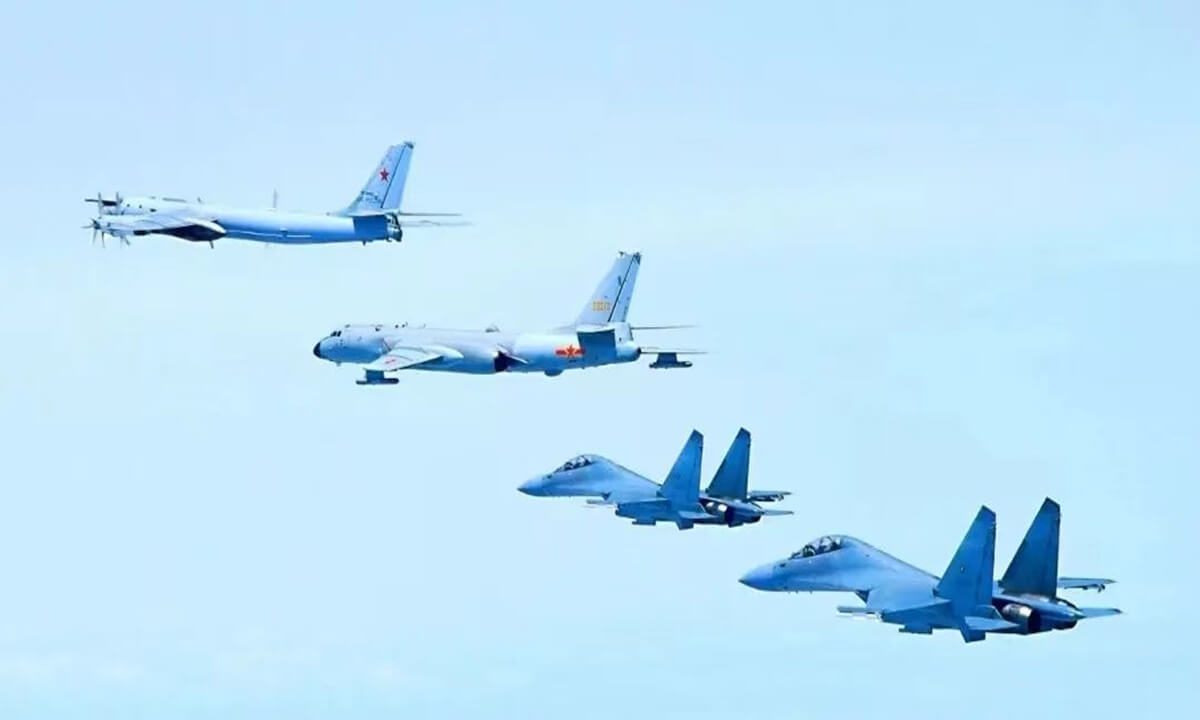On Wednesday, the South Korean military dispatched fighter jets, including F-15Ks, as two Chinese H-6 bombers and six Russian warplanes repeatedly entered and exited the Korea Air Defence Identification Zone (KADIZ).
“Our military dispatched air force fighter jets ahead of the Chinese and Russian aircraft’s entry of the KADIZ to implement tactical measures in preparation for a potential contingency,” South Korea’s Joint Chiefs of Staff (JCS) revealed, adding that they did not violate South Korean airspace.
According to the JCS, two Chinese warplanes first entered the KADIZ at 5:48 am local time from an area 126 kilometres (kms) northwest of the Ieo Islet, south of the southern island of Jeju, and left at 6:13 am before reentering at 6:44 am from northeast of South Korea’s port city of Pohang and exiting at 7:07 am.
Then, five hours later, the two Chinese jets were accompanied by six Russian warplanes, including four TU-95 bombers and SU-35 fighter jets, when they entered the KADIZ from 200 kms northeast of the Ulleung Island in the Sea of Japan, known in Seoul as the East Sea, and left 18 minutes later.
The Japanese Air Self Defence Force, too, scrambled fighter jets after the two Chinese bombers entered the Sea of Japan from the East China Sea, where they were joined by two Russian drones.
An air defence zone is an aerial space where countries ask foreign military aircraft to identify themselves, and are not under any international rules, unlike a country’s airspace. Nevertheless, it is expected for a foreign aircraft to get prior permission from a country’s military before entering an air defence zone.
Russia does not recognise KADIZ and China has previously said that all foreign military jets should enjoy freedom of movement there, as it is not territorial airspace. In fact, China’s air defence zone overlaps with South Korea and Japan’s, resulting in disputes such as the Ieodo underwater reefs, which are situated in territorial waters claimed by both Seoul and Beijing.
In a statement, the Chinese Ministry of National Defence revealed that the Chinese and Russian armed forces had “conducted routine joint aerial strategic patrol in the air space over the waters of the Sea of Japan, the East China Sea and the west Pacific Ocean.”
Similarly, the Russian Defence Ministry noted that the Russian bombers’ flight lasted about eight hours, and were accompanied by SU-30 and Su-35 fighter jets. It also said that both Chinese and Russian jets made cross-landings in each other’s territories “for the first time in the history of aerial patrolling.”
“In the course of accomplishing their missions, the aircraft of both countries acted in strict compliance with the provisions of international law. There were no violations of the airspace of foreign states,” the ministry added, stressing that the joint exercise was part of the 2022 military cooperation plan and that it was not directed against any third countries. It also remarked that foreign fighter jets escorted the bombers during some stages of the combined patrol, without naming South Korea.
Soon after South Korean President Yoon Suk-yeol took office in May, Chinese and Russian jets near Japanese and South Korean airspace. Similarly, in August, the South Korean JCS reported Russian warplanes entering the KADIZ.
In 2019, South Korean military aircraft fired hundreds of warning shots toward Russian jets when they entered the KADIZ during a joint air patrol with China.
The United States (US) and South Korea have intensified joint military drills in coordination with Japan and the Philippines to maintain stability in the Korean Peninsula due to the aggressive force postures from North Korea, China, and Russia. Washington has also warned them against changing the status quo in the region.
In fact, a senior US defence official said on Monday that the Chinese-Russian military exercises are often “a means of signaling their closer alignment and sending a message to the US and to other countries.”
South Korea Dispatches Jets as China, Russia Conduct ‘Routine’ Patrol in Air Defence Zone
The Japanese Air Self Defence Force, too, scrambled fighter jets after two Chinese bombers entered the Sea of Japan from the East China Sea, where they were joined by two Russian drones.
December 1, 2022

Two Chinese J-16 fighter jets conduct an escort mission for a Chinese H-6K bomber and a Russian Tu-95MS bomber in May. IMAGE SOURCE: GLOBAL TIMES
